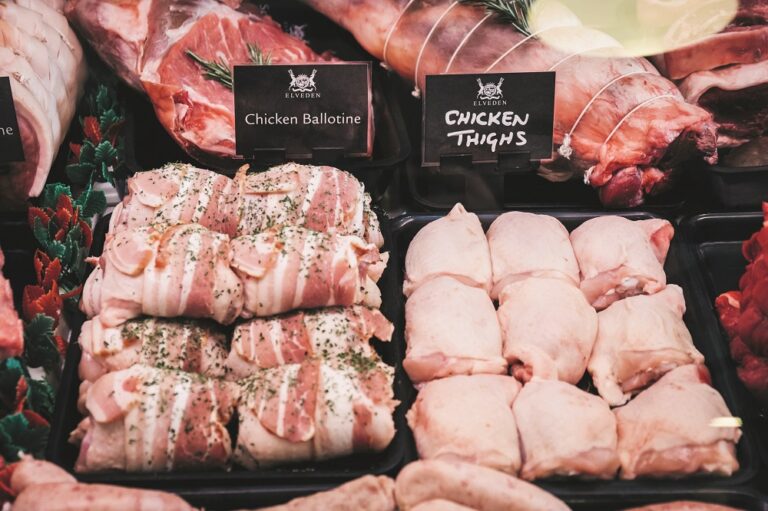Small butchers and farm shops are seeing an uptick in demand they liken to Christmas
The impact of the coronavirus on independent butchers has been mixed, with some forced to shut their doors if they mainly supply the foodservice sector, while others experiencing a surge in demand.
According to the trade association National Craft Butchers (NCB), some of its members have seen up to a five-fold increase in sales, driven by shoppers eating more meals at home and seeking to avoid busy supermarkets.
Butcher and small abattoir operator John Mettrick from Glossop says he had seen a huge increase in deliveries and had started to use a local taxi service for help. “Meat hampers, online orders for delivery and in-store multibuys have all seen marked increases,” he told the NCB. “Fortunately, due to short supply chains we haven’t run out of any meat so far. We are proud to be doing everything we can to meet demand at this difficult time. Our local and flexible supply lines have been a real advantage.”
George Debman a craft butcher from Ipswich has also experienced increased sales: “My staff and I are managing despite only having four or five hours sleep a night. Our customers have been magnificent, often queuing for 30 minutes but remaining cheerful.”
The increase in demand coupled with the need to introduce social distancing measures for staff and customers had led to some innovative ideas. One farm shop – Bert’s Barrow Farm Shop at Hillam, Yorkshire, run by Jason Thompson and Charlotte Wells Thompson – has closed its shop but has started offering a drive-through service and has seen sales rocket in the past few weeks.
“At first, they were trying to do lots of deliveries, and they were getting lots of orders and it was turning into a logisitical nightmare for them,” says Anna Longthorp, who supplies meat to the Thompsons. “have a board, so one of their team will stand there and point to the options, of a veg box, or a three for £10 meat pack, and the driver will do thumbs up or thumbs down.
“The team will put whatever they want in the boot, so they don’t even get out of the car, then they pay contactless through the window. It’s brilliant.”
According to Tony Goodger, of the Association of Independent Meat Suppliers (AIMS) catering butchers have had to rapidly adapt. “Some of our members have lost up to 80% of their business,” he says. “But they have been able to be very agile, and we have seen some introduce pop-up shops, click and collect businesses, and online shops.”
Advice for farm businesses selling direct to consumers
How do I go from being being a pure ‘bricks and mortar’ shop to selling products online? The Farm Retail Association has produced some advice on the main options for farm shops who have closed their physical shops but want to sell direct to consumers.
Although dozens of online agencies have been clambering to advertise their particular offer to food stores the Farm Retail Association advises caution; there really is no one size fits all solution.
Any solution adopted needs to fit around the type of business you have. This will include considerations such as, the amount of physical space inside and outside your shop, your current staff numbers and, crucially, your ability to deliver any goods purchased to customers, if customers coming to you is not practical.
THE ‘ONLINE SHOP’ OPTION
The most obvious solution for many retailers is to get online and to set up an e-commerce store.
From here, customers can review, select and pay for products as part of a single transaction. In this environment there is also an expectancy that the items ordered can be delivered to a specified address and that they will arrive in good condition. (i.e. Things like perishable items are still intact and meat and deli products are ‘chilled’ and still safe to consume.)
THE ‘CLICK & COLLECT’ OPTION
Sounds like the previous, online shopping, option but it’s not; this is less advanced than having a full e-commerce store.
In this scenario, you would have a fixed menu of products available via your website.
Customers would go to your site, select the quantities of the products they want and submit. Those quantities then get sent automatically to your back office system so you can prepare the order(s) for collection.
From this point, your team would generate a list of picking requirements from the back office and pack the orders.
Customers would then be informed by your team as to when they should come to collect and during what time slot.
THE ‘ORDER & COLLECT’ OPTION
This is the least advanced and most manual of all the options.
In this case, you would simply have your product ‘menu’ available on your website for customers to view or download. Once the customer has decided on what they require they would call you and simply place the order over the phone for fulfillment and agree a date and time with you for delivery or collection. Payment could be taken over the phone by card (if appropriate) or once the customer has arrived in store for collection.


